Articles Menu

January 18th 2021
There’s good news and bad news about Canada’s 2030 climate target.
The good news is that for the first time, Canada has proposed a way to meet a climate target. The government’s recently announced Healthy Environment and a Healthy Economy (HEHE) plan contains enough new climate policy proposals that, if implemented, will allow Canada to reach its 2030 target.
The bad news is, promises don’t cut emissions. Laws do. Climate laws enacted by Canadian politicians to date don’t come anywhere close to meeting our 2030 target. With time running out and a gigantic emissions gap to close, Canada needs to enact climate laws now — not just add to the "maybe later" pile.
For an example of how a proposed policy ends up delayed and watered down, consider Ottawa’s long-promised Clean Fuel Standard. It was going to be broadly applied and lead to a reduction of 30 million tonnes of CO2 (MtCO2) per year. But the policy still hasn’t been enacted, and the latest draft has a narrower scope that is expected to cut only 20 MtCO2 per year. As we will see in more detail below, Canada needs a lot more climate laws on the books.
The ugly part of the plan is how it ignores the flood of emissions pouring out of Canada’s managed forestry sector and instead claims this sector is a source of "net GHG removals." Over the last decade, logging emissions have vastly exceeded what our nation’s managed forests have absorbed. This carbon imbalance has created a flood of net GHG additions into, not removals from, the atmosphere, worsening the climate crisis.
Pencil-pushing this huge source of CO2 off the books won’t fool the climate. We need to rein in all our excess CO2 emissions if we want a safe and sane climate future.
To illustrate these good, bad and ugly parts of Canada’s 2030 plan, I’ve created a series of charts from the government’s latest emissions inventory and projections.
First, the goal.
Both the Harper Conservative government and Trudeau Liberal government that followed committed Canada to the same climate target for 2030.
In his latest series of charts, @bsaxifrage explains the good, the bad and the ugly of Canada's 2030 climate plan for @natobserver - Twitter
To illustrate this visually, my first chart shows that task as a green arrow stretching from the 2005 starting line on the left, to the 2030 goal line on the right.
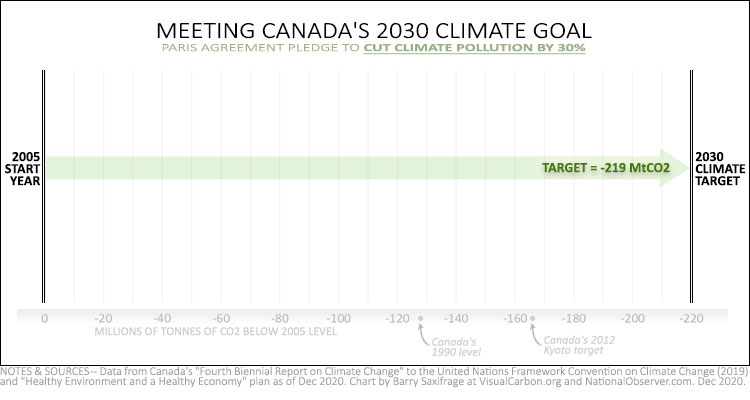
Next, let’s see how far Canada’s current federal and provincial climate policies will get us.
The chart below now includes coloured bars for each sector of the economy. The length of these bars indicates the projected change in emissions between 2005 and 2030 given current policies.
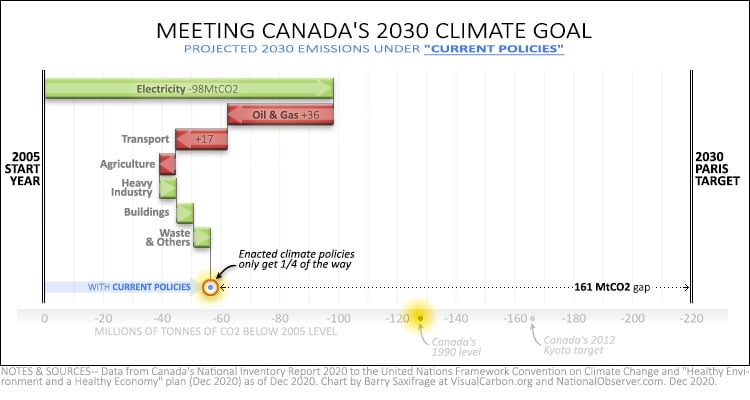
The blue arrow in the bottom left shows the net result for Canada. As you can see, the policies actually on the books fall far short of what is needed.
Canadian politicians have been promising to cut our too-high emissions for 30 years. And yet, all the climate laws enacted over those three decades are too weak to even knock our emissions back to the 1990 starting line, which was already too high.
This can be seen by comparing the chart’s two yellow highlights. The one on the right shows Canada's 1990 emissions level. The one on the left is where our emissions are expected to be a decade from now under current policies — still 70 MtCO2 higher per year than they were in 1990.
Decades of Canada’s climate laws continue to be, even now in 2021, massively undersized compared to Canada’s promises.
Before moving on to look at the current crop of promises, it’s worth underlining the three sectors that dominate the chart above.
Electricity — As the top green bar on the chart shows, under current policies, almost all of Canada’s emissions cuts are expected to come from the electricity generation sector. It’s on track to reduce its annual emissions by nearly 100 MtCO2. This is being driven by two major climate policies. First, Ontario’s decision to eliminate coal-fired generation. Second, laws passed by the federal government to phase out coal-fired generation nationwide.
Oil and gas — At the other extreme, the red bar for the oil and gas extraction sector shows that it is on track to significantly increase its climate pollution. Under current policies, this sector is projected to emit 36 MtCO2 more in 2030 than it did in 2005. The primary driver is rising amounts of fossil carbon being extracted by the Alberta oilsands industry.
Transportation — The other big red bar on the chart is the transportation sector. Canadians continue to purchase and drive the world’s most climate-polluting cars. Clearly, all the climate laws enacted so far haven’t done much to rein in this pollution beast. As a result, transportation emissions under current policies are projected to be 17 MtCO2 higher per year by 2030 than they were in 2005.
Now let’s look at the good news side: potential reductions from all the promised climate policies.
I’ve added purple bars to the chart to show the projected impact of all the proposed climate policies. (Note: These projections assume all proposed policies get enacted at full strength and on time.)
As you can see, these would lower Canada’s 2030 emissions to within 20 MtCO2 of our target. Getting that close would certainly count as good news in my book given Canada’s huge over-polluting misses so far.

Chart of Canada’s 2030 climate plan — Part 3: Projected impact with all proposed policies
And there is additional good news revealed by all those purple bars. Every sector, except agriculture, would be required to reduce emissions. That would also be a first for Canada. So far, Canada’s two most climate polluting sectors — oil and gas extraction, and transportation — have been allowed to increase emissions.
This failure to rein in the two most-polluting sectors has been at the heart of Canada’s multi-decade climate failure. It will be a major step towards climate sanity in Canada when these two sectors start making big emissions cuts.
And what about that remaining 20 MtCO2 gap to the target?
The government says it plans to close it using "net GHG removals" from Canada’s forestry sector.
The idea that our forestry sector claims to remove climate pollution from the atmosphere is mind-boggling to me. Take a look at this next chart showing forest carbon data from Canada’s latest official National Inventory Report.
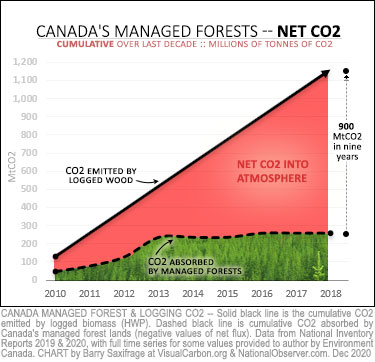
The rising black line on the chart shows the CO2 emitted by all the wood logged in Canada. It has totalled nearly 1,200 MtCO2 over the last decade. To be clear, this is the CO2 emitted into the atmosphere when the wood was burned for energy, or rotted after being discarded.
Now compare those CO2 emissions from the logging sector, to the green area on that chart. That’s how much CO2 Canada’s managed forests absorbed over those years — just 300 MtCO2.
The excess 900 MtCO2, shown in red, has been piling up in our atmosphere, worsening the climate crisis. This flood of CO2 has grown into a serious and surging climate threat. Pretending it doesn’t exist won’t make the threat magically disappear.
If we want to stop the climate crisis from worsening, we must shut down this rising tide of CO2 into the atmosphere. It now totals more than a billion tonnes of CO2 over the last decade. That’s more than most Canadian sectors or provinces emitted over those years.
Ottawa’s 2030 climate plan, however, ignores these emissions. That certainly hasn’t been easy, because all those emissions used to be on Canada’s official carbon books. The effort to push this CO2 off the books has required a series of creative carbon accounting changes over the last few years.
But pencil-pushing climate pollution off the books doesn’t remove it from the atmosphere.
If we want a safe climate future, then Ottawa’s climate plans must stop contorting this rising CO2 flood into supposed carbon credits — and start reducing the threat.
Above, we saw how Canada’s 2030 plan aims to meet the target. I’ll finish up by looking at how that plan divides the burden of emission reductions across the sectors.
My next chart lets you see the percentage changes projected for each.
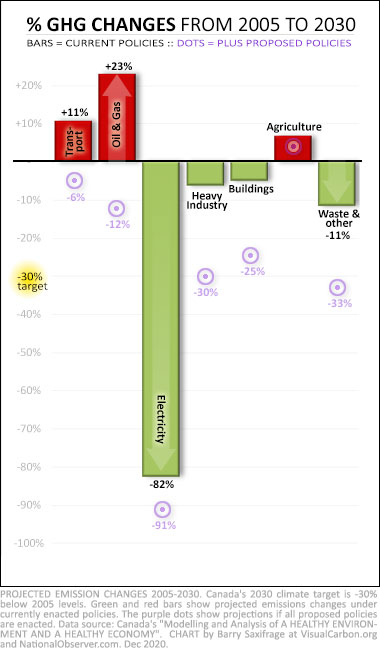
The bars show changes under current policies.
For example, the red bar for the oil and gas sector shows that it would be allowed to emit 23 per cent more in 2030 than it did in 2005 under current laws.
Conversely, the green bar for the electricity sector shows that its emissions would fall 82 per cent under current laws.
And the purple dots show the changes expected under proposed policies.
In this more hopeful scenario, all sectors except agriculture would end up with lower emissions in 2030 than in 2005.
But the percentage of cuts vary widely.
For example, Canada’s two most climate polluting sectors would reduce emissions by a smaller percentage than the national average. Transportation would be targeted for just a six per cent reduction from 2005.
Three other sectors would be targeted for reductions that are roughly in line with the national target of 30 per cent. These are the heavy industry sector, buildings and the waste sector.
And the electricity sector would be targeted for an impressive 91 per cent reduction from its 2005 level by 2030. This rapid decarbonizing of an entire sector has been the big climate success story for Canada.
But this success now poses a thorny policy problem going forward.
As the charts above have shown, Canada has relied on this one sector to make nearly all the nation’s big emissions cuts. But that strategy won’t work anymore because there’s just not enough electricity sector emissions left to cut. This is now forcing Canada to find big emissions cuts elsewhere. And that means Ottawa must now target the emissions from oil and gas and transportation sectors to make future progress.
My next chart shows why.
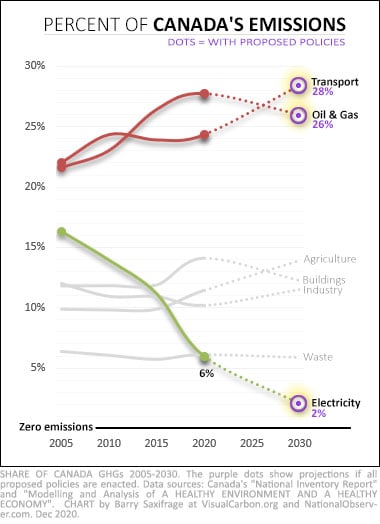
On this chart, each sector has a line that shows its share of Canada’s emissions since 2005.
The green line shows the electricity sector. Its emissions are currently down to just six per cent of the nation’s total. This is now the least-emitting sector in Canada. And it’s headed to only two per cent by 2030.
In contrast, the red lines show that the oil and gas and transport sectors’ emissions have steadily increased their dominance of Canada’s emissions. Combined, they now emit over half of Canada’s climate pollution.
And as the purple dots at the end of those lines show, their combined share is expected to be even higher by 2030 — even with all the newly proposed policies in the HEHE plan.
Simple math requires the biggest emissions cuts to now come from these two sectors. That’s because they are now the lion’s share of the problem.
The hopeful news is that Canada has shown, via its electricity sector, that it can enact the laws needed to virtually eliminate climate pollution within 25 years from one of its major emitting sector. Now Ottawa needs to act just as quickly to rein in its remaining super-emitting sectors.
[Top image: For the first time, Canada has proposed a way to meet its climate targets, but it will take a lot more tough legislation to rein in emissions, writes Barry Saxifrage. Photo from NASA]